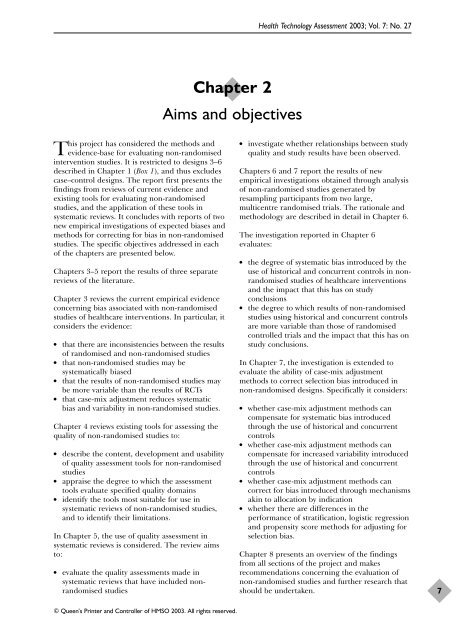Evaluating non-randomised intervention studies - NIHR Health ...
Evaluating non-randomised intervention studies - NIHR Health ...
Evaluating non-randomised intervention studies - NIHR Health ...
You also want an ePaper? Increase the reach of your titles
YUMPU automatically turns print PDFs into web optimized ePapers that Google loves.
<strong>Health</strong> Technology Assessment 2003; Vol. 7: No. 27Chapter 2Aims and objectivesThis project has considered the methods andevidence-base for evaluating <strong>non</strong>-<strong>randomised</strong><strong>intervention</strong> <strong>studies</strong>. It is restricted to designs 3–6described in Chapter 1 (Box 1), and thus excludescase–control designs. The report first presents thefindings from reviews of current evidence andexisting tools for evaluating <strong>non</strong>-<strong>randomised</strong><strong>studies</strong>, and the application of these tools insystematic reviews. It concludes with reports of twonew empirical investigations of expected biases andmethods for correcting for bias in <strong>non</strong>-<strong>randomised</strong><strong>studies</strong>. The specific objectives addressed in eachof the chapters are presented below.Chapters 3–5 report the results of three separatereviews of the literature.Chapter 3 reviews the current empirical evidenceconcerning bias associated with <strong>non</strong>-<strong>randomised</strong><strong>studies</strong> of healthcare <strong>intervention</strong>s. In particular, itconsiders the evidence:●●●●that there are inconsistencies between the resultsof <strong>randomised</strong> and <strong>non</strong>-<strong>randomised</strong> <strong>studies</strong>that <strong>non</strong>-<strong>randomised</strong> <strong>studies</strong> may besystematically biasedthat the results of <strong>non</strong>-<strong>randomised</strong> <strong>studies</strong> maybe more variable than the results of RCTsthat case-mix adjustment reduces systematicbias and variability in <strong>non</strong>-<strong>randomised</strong> <strong>studies</strong>.Chapter 4 reviews existing tools for assessing thequality of <strong>non</strong>-<strong>randomised</strong> <strong>studies</strong> to:●●●describe the content, development and usabilityof quality assessment tools for <strong>non</strong>-<strong>randomised</strong><strong>studies</strong>appraise the degree to which the assessmenttools evaluate specified quality domainsidentify the tools most suitable for use insystematic reviews of <strong>non</strong>-<strong>randomised</strong> <strong>studies</strong>,and to identify their limitations.In Chapter 5, the use of quality assessment insystematic reviews is considered. The review aimsto:●evaluate the quality assessments made insystematic reviews that have included <strong>non</strong><strong>randomised</strong><strong>studies</strong>●investigate whether relationships between studyquality and study results have been observed.Chapters 6 and 7 report the results of newempirical investigations obtained through analysisof <strong>non</strong>-<strong>randomised</strong> <strong>studies</strong> generated byresampling participants from two large,multicentre <strong>randomised</strong> trials. The rationale andmethodology are described in detail in Chapter 6.The investigation reported in Chapter 6evaluates:●●the degree of systematic bias introduced by theuse of historical and concurrent controls in <strong>non</strong><strong>randomised</strong><strong>studies</strong> of healthcare <strong>intervention</strong>sand the impact that this has on studyconclusionsthe degree to which results of <strong>non</strong>-<strong>randomised</strong><strong>studies</strong> using historical and concurrent controlsare more variable than those of <strong>randomised</strong>controlled trials and the impact that this has onstudy conclusions.In Chapter 7, the investigation is extended toevaluate the ability of case-mix adjustmentmethods to correct selection bias introduced in<strong>non</strong>-<strong>randomised</strong> designs. Specifically it considers:●●●●whether case-mix adjustment methods cancompensate for systematic bias introducedthrough the use of historical and concurrentcontrolswhether case-mix adjustment methods cancompensate for increased variability introducedthrough the use of historical and concurrentcontrolswhether case-mix adjustment methods cancorrect for bias introduced through mechanismsakin to allocation by indicationwhether there are differences in theperformance of stratification, logistic regressionand propensity score methods for adjusting forselection bias.Chapter 8 presents an overview of the findingsfrom all sections of the project and makesrecommendations concerning the evaluation of<strong>non</strong>-<strong>randomised</strong> <strong>studies</strong> and further research thatshould be undertaken.7© Queen’s Printer and Controller of HMSO 2003. All rights reserved.
















